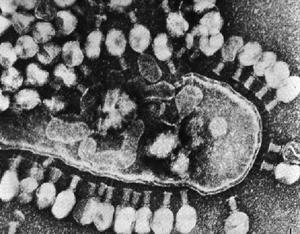Viruses are curious things in nature. They are so bizarre that some scientists doubt they even fit the qualifications of a living thing. However, they are so pervasive in nature and our everyday lives that they are still vastly important alive or not alive. Virus reproduction is one of the most interesting features of these microscopic anomalies, and is responsible for their success on earth.
Before going into virus reproduction, it is important to know what a virus exactly is. Most viruses are slightly larger than proteins, which are slightly larger than atoms. This means that viruses are vastly smaller than even the smallest bacteria. Although virus structure varies from type to type, most viruses contain genetic material in the form of RNA or DNA encased in a protein coat. The virus then has projections responsible for its mobility such as tail fibers or primitive types of cilia. For brevity’s sake, we will focus on what are known as complex viruses. These viruses have a “head” that consists of a protein covering somewhat resembling a crystal or gemstone with several flat faces. Inside this head is the virus’ genetic material. A type of complex virus that infects bacteria, called a bacteriophage, possesses a distinctive “stem” joining the head and tail structures of the virus.
Now that we know the basic parts of a complex virus, we can begin to examine their method of reproduction. Viruses cannot reproduce on their own by either asexual or sexual means. Bacteria can reproduce asexually by dividing in half, and organisms like humans can reproduce sexually using specialized reproductive cells. Viruses can do neither of these things, so virus reproduction must take place some other way. In fact, the only way viruses can reproduce is by infecting a host cell. In this sense, all viruses are microscopic parasites that prey on cells in order to reproduce. Since viruses are acellular, they depend on the machinery of prokaryotic or eukaryotic cells to do their dirty work.
A cell is an interconnected system of functions. Individual cells can produce fuel, detoxify chemicals, attack other cells, as well as a myriad other functions. Viruses evolved a specialized way to exploit the inner machinery of cells for their own purposes. First, a virus must get inside a cell. Bacteriophages bind to certain receptor sites that allow their entry, while other viruses that infect human cells are able to enter via certain protein channels. Once inside the cell, a virus lets loose its genetic information. This information, once absorbed by protein-making organelles in the cell, will form a template for new protein production-viral protein production. So, in effect the virus’ DNA or RNA causes the host cell to start churning out copies of itself. While a virus can’t reproduce by itself because it lacks the necessary equipment, it is able to exploit the equipment of cells. Think of a car factory that is taken over by a government and forced to make tanks instead of cars. That’s sort of how virus reproduction works.
Viruses can tell a cell to make hundreds or thousands of copies of themselves, but they’re still trapped inside the cell. Some cells have natural defense mechanisms that cause the cell to kill itself if something threatens it enough. These cells kill themselves by lysing (popping) their cell membranes which causes the interior of the cell to spill outward. This not only releases the contents of the cell, but also the hundreds of new viruses that will proceed to infect new cells. Some viruses such as bacteriophages actually contain enzymes that help to degrade cell membranes. When the integrity of the membrane is shot, then the viruses will be released, much like water from a popped water balloon.
Virus reproduction is one of the most interesting and terrifying facets of evolution. Although most viruses don’t cause irreparable damage to humans, the idea of our cells being taken over by things we cannot see is pretty scary.


